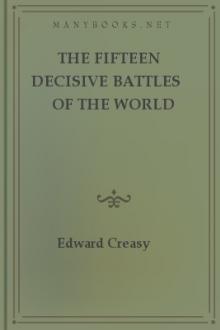Falling in Love by Grant Allen (different e readers .txt) 📕

- Author: Grant Allen
- Performer: -
Book online «Falling in Love by Grant Allen (different e readers .txt) 📕». Author Grant Allen
On the other hand, it seems pretty clear that certain plants have efficiently armed themselves against the aphides, in turn, by secreting bitter or otherwise unpleasant juices. So far as I can discover, the little plunderers seldom touch the pungent 'nasturtiums' or tropsælums of our flower-gardens, even when these grow side by side with other plants on which the aphides are swarming. Often, indeed, I find winged forms upon the leaf-stem of a nasturtium, having come there evidently in hopes of starting a new colony; but usually in a dead or dying condition—the pungent juice seems to have poisoned them. So, too, spinach and lettuce may be covered with blight, while the bitter spurges, the woolly-leaved arabis, and the strong-scented thyme close by are utterly untouched. Plants seem to have acquired all these devices, such as close networks of hair upon the leaves, strong essences, bitter or pungent juices, and poisonous principles, mainly as deterrents for insect enemies, of which caterpillars and plant-lice are by far the most destructive. It would be unpardonable, of course, to write about honey-dew without mentioning tobacco; and I may add parenthetically that aphides are determined anti-tobacconists, nicotine, in fact, being a deadly poison to them. Smoking with tobacco, or sprinkling with tobacco-water, are familiar modes of getting rid of the unwelcome intruders in gardens. Doubtless this peculiar property of the tobacco plant has been developed as a prophylactic against insect enemies: and if so, we may perhaps owe the weed itself, as a smokable leaf, to the little aphides. Granting this hypothetical connection, the name of honey-dew would indeed be a peculiarly appropriate one. I may mention in passing that tobacco is quite fatal to almost all insects, a fact which I present gratuitously to the blowers of counterblasts, who are at liberty to make whatever use they choose of it. Quassia and aloes are also well-known preventives of fly or blight in gardens.
The most complete life-history yet given of any member of the aphis family is that which M. Jules Lichtenstein has worked out with so much care in the case of the phylloxera of the oak-tree. In April, the winter eggs of this species, laid in the bark of an oak, each hatch out a wingless imperfect female, which M. Lichtenstein calls the foundress. After moulting four times, the foundress produces, by parthenogenesis, a number of false eggs, which it fastens to the leaf-stalks and under side of the foliage. These false eggs hatch out a larval form, wingless, but bigger than any of the subsequent generations; and the larvæ so produced themselves once more give origin to more larvæ, which acquire wings, and fly away from the oak on which they were born to another of a different species in the same neighbourhood. There these larvæ of the second crop once more lay false eggs, from which the third larval generation is developed. This brood is again wingless, and it proceeds at once to bud out several generations more, by internal gemmation, as long as the warm weather lasts. According to M. Lichtenstein, all previous observations have been made only on aphides of this third type; and he maintains that every species in the whole family really undergoes an analogous alternation of generations. At last, when the cold weather begins to set in, a fourth larval form appears, which soon obtains wings, and flies back to the same kind of oak on which the foundresses were first hatched out, all the intervening generations having passed their lives in sucking the juices of the other oak to which the second larval form migrated. The fourth type here produce perfect male and female insects, which are wingless, and have no sucking apparatus. The females, after being impregnated, lay a single egg each, which they hide in the bark, where it remains during the winter, till in spring it once more hatches out into a foundress, and the whole cycle begins over again. Whether all the aphides do or do not pass through corresponding stages is not yet quite certain. But Kentish farmers believe that the hop-fly migrates to hop-bines from plum-trees in the neighbourhood; and M. Lichtenstein considers that such migrations from one plant to another are quite normal in the family. We know, indeed, that many great plagues of our crops are thus propagated, sometimes among closely related plants, but sometimes also among the most widely separated species. For example, turnip-fly (which is not an aphis, but a small beetle) always begins its ravages (as Miss Ormerod has abundantly shown) upon a plot of charlock, and then spreads from patches of that weed to the neighbouring turnips, which are slightly diverse members of the same genus. But, on the other hand, it has long been well known that rust in wheat is specially connected with the presence of the barberry bush; and it has recently been proved that the fungus which produces the disease passes its early stages on the barberry leaves, and only migrates in later generations to the growing wheat. This last case brings even more prominently into light than ever the essential resemblance of the aphides to plant-parasites.
THE MILK IN THE COCO-NUTFor many centuries the occult problem how to account for the milk in the coco-nut has awakened the profoundest interest alike of ingenuous infancy and of maturer scientific age. Though it cannot be truthfully affirmed of it, as of the cosmogony or creation of the world, in the 'Vicar of Wakefield,' that it 'has puzzled the philosophers of all ages' (for Sanchoniathon was certainly ignorant of the very existence of that delicious juice, and Manetho doubtless went to his grave without ever having tasted it fresh from the nut under a tropical verandah), yet it may be safely asserted that for the last three hundred years the philosopher who has not at some time or other of his life meditated upon that abstruse question is unworthy of such an exalted name. The cosmogony and the milk in the coco-nut are, however, a great deal closer together in thought than Sanchoniathon or Manetho, or the rogue who quoted them so glibly, is ever at all likely, in his wildest moments, to have imagined.
The coco-nut, in fact, is a subject well deserving of the most sympathetic treatment at the gentle hands of grateful humanity. No other plant is useful to us in so many diverse and remarkable manners. It has been truly said of that friend of man, the domestic pig, that he is all good, from the end of his snout to the tip of his tail; but even the pig, though he furnishes us with so many necessaries or luxuries—from tooth-brushes to sausages, from ham to lard, from pepsine wine to pork pies—does not nearly approach, in the multiplicity and variety of his virtues, the all-sufficing and world-supplying coco-nut. A Chinese proverb says that there are as many useful properties in the coco-nut palm as there are days in the year; and a Polynesian saying tells us that the man who plants a coco-nut plants meat and drink, hearth and home, vessels and clothing, for himself and his children after him. Like the great Mr. Whiteley, the invaluable palm-tree might modestly advertise itself as a universal provider. The solid part of the nut supplies food almost alone to thousands of people daily, and the milk serves them for drink, thus acting as an efficient filter to the water absorbed by the roots in the most polluted or malarious regions. If you tap the flower stalk you get a sweet juice, which can be boiled down into the peculiar sugar called (in the charming dialect of commerce) jaggery; or it can be fermented into a very nasty spirit known as palm-wine, toddy, or arrack; or it can be mixed with bitter herbs and roots to make that delectable compound 'native beer.' If you squeeze the dry nut you get coco-nut oil, which is as good as lard for frying when fresh, and is 'an excellent substitute for butter at breakfast,' on tropical tables. Under the mysterious name of copra (which most of us have seen with awe described in the market reports as 'firm' or 'weak,' 'receding' or 'steady') it forms the main or only export of many Oceanic islands, and is largely imported into this realm of England, where the thicker portion is called stearine, and used for making sundry candles with fanciful names, while the clear oil is employed for burning in ordinary lamps. In the process of purification, it yields glycerine; and it enters largely into the manufacture of most better-class soaps. The fibre that surrounds the nut makes up the other mysterious article of commerce known as coir, which is twisted into stout ropes, or woven into coco-nut matting and ordinary door-mats. Brushes and brooms are also made of it, and it is used, not always in the most honest fashion, in place of real horse-hair in stuffing cushions. The shell, cut in half, supplies good cups, and is artistically carved by the Polynesians, Japanese, Hindoos, and other benighted heathen, who have not yet learnt the true methods of civilised machine-made shoddy manufacture. The leaves serve as excellent thatch; on the flat blades, prepared like papyrus, the most famous Buddhist manuscripts are written; the long mid-ribs or branches (strictly speaking, the leaf-stalks) answer admirably for rafters, posts, or fencing; the fibrous sheath at the base is a remarkable natural imitation of cloth, employed for strainers, wrappers, and native hats; while the trunk, or stem, passes in carpentry under the name of porcupine wood, and produces beautiful effects as a wonderfully coloured cabinet-makers' material. These are only a few selected instances out of the innumerable uses of the coconut palm.
Apart even from the manifold merits of the tree that bears it, the milk itself has many and great claims to our respect and esteem, as everybody who has ever drunk it in its native surroundings will enthusiastically admit. In England, to be sure, the white milk in the dry nuts is a very poor stuff, sickly, and strong-flavoured, and rather indigestible. But in the tropics, coco-nut milk, or, as we oftener call it there, coco-nut water, is a very different and vastly superior sort of beverage. At eleven o'clock every morning, when you are hot and tired with the day's work, your black servant, clad from head to foot in his cool clean white linen suit, brings you in a tall soda glass full of a clear, light, crystal liquid, temptingly displayed against the yellow background of a chased Benares brass-work tray. The lump of ice bobs enticingly up and down in the centre of the tumbler, or clinks musically against the edge of the glass as he carries it along. You take the cool cup thankfully and swallow it down at one long draught; fresh as a May morning, pure as an English hillside spring, delicate as—well, as coco-nut water. None but itself can be its parallel. It is certainly the most delicious, dainty, transparent, crystal drink ever invented. How did it get there, and what is it for?
In the early green stage at which coco-nuts are generally picked for household use in the tropics the shell hasn't yet solidified into a hard stony coat, but still remains quite soft enough





Comments (0)